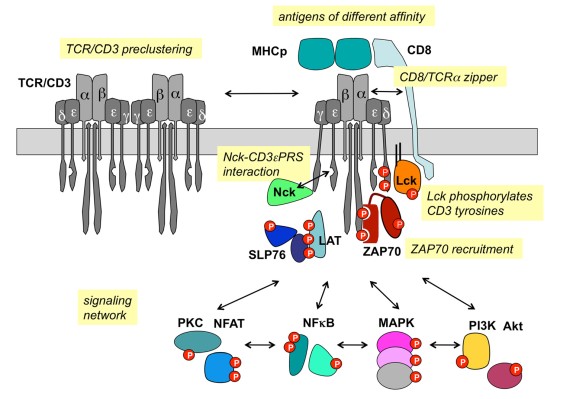Hi-Affi™ hCD19/hCD3e Dual Humanized Mouse Model
Bispecific antibodies (BsAbs) that use CD3e as one of their targets have become one of the "gold mines" in the development of targeted tumor therapeutic drugs. For example, the Blinatumomab targeting both CD3e and CD19 is a well-known drug for acute lymphoblastic leukemia (ALL). Creative Biolabs has successfully established an optimized Hi-Affi™ “humanized” animal platform to offer specialty manipulated hCD19/hCD3e dual humanized mice for our clients all over the world.
hCD19/hCD3e Molecule
Human CD19 (hCD19) is a surface protein expressed on B lymphocytes and follicular dendritic cells (DCs). It belongs to the immunoglobulin superfamily. The hCD19 gene is located on the short arm of chromosome 16 (16p11.2). hCD19 contains 556 amino acids and is a type I transmembrane glycoprotein with a molecular weight of 95 kDa. There are an N-terminal and two C2-Ig regions outside the cell, while a C-terminal and highly conserved functional regions containing 9 tyrosine intracellularly. hCD19 can be detected in acute lymphoblastic leukemia (ALL) and acute leukemia orientation tube (ALOT).
Human CD3e (hCD3e) is a single-pass type I membrane glycoprotein on the surface of T cells. hCD3e is a 20 kDa non-glycosylated polypeptide chain. The hCD3e molecule contains one Ig-like (immunoglobulin-like) domain and one ITAM domain. hCD3e molecules were first detected in early thymocytes, which may be one of the earliest signs of T cell lineage commitment. hCD3e molecules in cortical thymocytes are mainly located in the cytoplasm. However, in medullary thymocytes, they appear on the surface of T cells. hCD3e molecular antigen is a highly specific marker for T cells and can be detected in most tumors.
hCD19/hCD3e Signal Pathway
hCD19 regulates B cell development, proliferation, and differentiation in both B cell receptor (BCR) dependent and independent manners. hCD19, hCD21, hCD81, and hCD225 together form a BCR complex, which reduces the threshold of BCR-mediated B cell activation. By binding to the complement component C3d of the antigen and forming the hCD21/hCD19/hCD81 co-receptor, it migrates to the lipid raft to activate the downstream signaling pathway and participate in the activation of B cells. Studies have shown that hCD19 plays a role in B-cell malignant transformation in a BCR-independent manner by stabilizing c-Myc concentration in cells.
The hCD3e molecule forms a T cell receptor-CD3 complex together with CD3-γ, CD3-δ and CD3-ζ, and T cell receptor α/β and γ/δ heterodimers. This complex plays an important role in coupling antigen recognition to multiple intracellular signal transduction pathways. After antigen binding, the basic amino acid-rich regions (BRS) in the cytoplasmic tail of the CD3e and CD3ζ subunits are positively charged and can interact with the inside of the cell membrane rich in acidic phospholipids (negatively charged) through charge interaction. The proline-rich sequence (PRS) of the CD3e subunit is exposed and binds to the adaptor protein Nck, which plays an important role in TCR signal transmission. CD3e is essential for T cell activation and proper T cell development.
 Fig.1 The TCR/CD3 signal pathway. (Louis-Dit-Sully, 2012)1,2
Fig.1 The TCR/CD3 signal pathway. (Louis-Dit-Sully, 2012)1,2
Development of hCD19/hCD3e Dual Humanized Mice
hCD3e is one of the four subunits of the CD3 co-receptor. It binds to the T cell receptor (TCR) to participate in antigen recognition and intracellular signal transduction, and plays an important role in the immune response. hCD19 is a well-known target for B-cell linage malignancies. The BsAbs, which contain an anti-hCD3e antigen-binding site that attracts T lymphocytes to tumor cells and the other antigen-binding site targets tumor cell-specific antigens (such as hCD19), exhibit potential efficacy in B-cell linage malignancies. Creative Biolabs has accumulated much experience in drug development projects using Hi-Affi™ “humanized” animal models, including the hCD19/hCD3e dual humanized mice. If you are interested in these humanized mice or have any questions about your study project, please feel free to contact us for further discussions.
Creative Biolabs also offers other various Humanized Mouse Models you may be interested in:
References
- Louis-Dit-Sully, C.; et al. ICOS-L as a potential therapeutic target for cancer immunotherapy. Cell Commun Signal. 2012, 10(1): 11.
- under Open Access license CC BY 4.0, without modification.
For Research Use Only.
